Program Notes by Charlotte Nediger
The tradition of reciting the Passion, or the story of the Crucifixion as recorded in the Gospels of Matthew, Mark, Luke, and John, was established as early as the fourth century. The texts were read as Gospel lessons during Holy Week, and were to be recited “in a solemn manner.” This manner of recitation, or chant, gradually took on a rough musical and dramatic shape. Manuscripts from the ninth century, for example, include annotations of pitch, tempo, and volume, all indicated by a system of litterae significativae (literally, “significant letters”). The text was divided between an Evangelist, reciting the narrative sections; the role of Christ; and the turba, the latter including the various individuals in the Passion and the people as a whole.
This early framework provided the model for the post-Reformation Lutheran Passion settings. The pastor and other clergy intoned the narrative roles of the Evangelist and Christ, the choir sang the increasingly complexturba choruses, and the congregation responded with chorale hymns. Toward the end of the 17th century, the influence of the new baroque form of the sacred oratorio was felt, and the new “oratorio Passion” became popular. Instruments, previously barred from the church during Lent, were introduced. The traditional recitation tones were replaced by composed recitative. Lyrical poems and reflective verses were inserted in the text, set as solo arias and choruses. Early in the 18th century, Hamburg was the birthplace of the “Passion oratorio”: scripture was replaced by completely original texts in large-scale settings that were almost operatic in style and often presented in concert halls or at court, entirely removed from the divine service.
There were many who were offended by such secular presentations of such a quintessentially sacred subject. The Town Council of Leipzig was among them. The influence of traditional Lutheran theology was still strong in Leipzig, and upon accepting the position of Thomaskantor in 1723, Bach had to agree to write works “which would not be of an operatic nature, but would rather excite the listener to greater piety.” For almost two centuries, the Passion had been performed on Good Friday in Leipzig in a simple setting by Johann Walter, with the scripture recited in plainchant and simple choral responses. The first Passion of the “modern” type, composed by Telemann, was heard in Leipzig in the Neukirche in 1717. The Town Council reluctantly agreed in 1721 to introduce concerted Passions in the principal churches of St Thomas and St Nicholas, adapting the Vespers liturgy to allow for a Passion performance in two parts, one on either side of the sermon. The first was a very modest offering by Bach’s predecessor, Johann Kuhnau.
Bach’s St John Passion was first performed on Good Friday in 1724, as he approached the end of his first year in Leipzig. Like that of Kuhnau, and as required by his employers, it is an oratorio Passion, the narrative text drawn directly from the scriptures (St John 18–19). To this is added two additional layers of text: free verses set as arias, offering a deeply personal response to the narrative; and old Lutheran chorales, newly harmonized but with melodies that were very familiar to the congregation, offering a collective response. The whole is framed by Bach with two large-scale choruses, introducing a sense of the monumental.
It is unknown whether Bach, well versed in Lutheran theology, assembled the poetic texts of the non-narrative portions himself, or whether he worked with a librettist. The choice of chorales, so essential to the overall structure of the work, was probably made by Bach, as was also the incorporation of two passages from the Gospel of St Matthew into the narrative to allow for more affecting representations of Peter’s remorse and of the earthquake that follows Jesus’ death.
Bach revisited the St John Passion on several occasions over a period of 25 years, each time making revisions. For this week’s performances we are presenting the version prepared for the Good Friday service in 1749, a year before Bach’s death. The intensity of the experience of both hearing and performing a Passion is heightened by the baroque practice of the principal singers participating in all aspects: the narrative, the arias, and the choruses. For example, the baritone who sings the part of Jesus also sings the aria reflecting on Jesus' death; Pilatus addresses the crowd, yet also sings with them. In Bach’s time the four principal singers would have sung throughout, including all of the choral portions. We have moderated this practice to allow voices to manage four consecutive concert performances. Our ripieno group — the choir — is larger than Bach would have known, but this allows the principal singers to sing only a portion of the choral movements. However, the basic premise of inclusion is key to experiencing the Passion as Bach and his contemporaries would have understood it, both on a personal and communal level.
Photo: Kathryn Hosier, detail, Karolina Kuras

